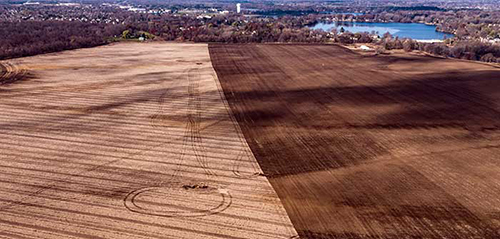
Neighbors help neighbors, and sometimes they lift up a community. That’s the case in Elk River, Minnesota, where a family has given the city a present that will keep giving for generations to come.
The gift: William H. Houlton Conservation Area. It’s a bequest from the Houlton family, whose roots here run deep.
The family made the gift with help, in part, from the U.S. Fish and Wildlife Service (Service).
The Houlton family has been part of Elk River, Minnesota, for seven generations. In 1854, William H. Houlton traveled from Maine on a covered wagon to become one of the city’s founders. In 1872, he acquired the first parcel of what would become the 335-acre family farm. It was good land, bounded by the Elk and Mississippi rivers. There, W.H. began raising cattle, growing cash crops and operating lumber mills.
The mills closed in the early 20th century. Then dairy cows replaced the cattle. Hybrid corn and soybean became the main cash crops.
Something else happened, too. As the years went by, the farm became one of the largest undeveloped riverfront properties between Elk River and Hastings, Minnesota—municipalities more than 50 miles apart, with a combined population of more than 3 million.
When W.H. Houlton’s descendent, John Houlton, sold the property to the city of Elk River four years ago, he gave the community a chance to restore the William H. Houlton Conservation Area for hunters, anglers and other recreational users.
“This was a dream of my father,” said John Houlton. “Our family has always been conservation-minded, and we wanted to preserve the land for our community to have low-impact access.”
Houlton grew up on this land, living a Huckleberry Finn life. He camped along the river banks, built forts in the woods, and watched river otters play and waterfowl migrate.
In late 2014, Houlton sold the farm to the city of Elk River through the non-profit Trust for Public Lands. It took more than a year to finalize the purchase with help from the Service.
The Service assisted the Trust in purchasing the farm with cash from the Outdoor Heritage Fund, which was created by a Minnesota funding amendment to set aside money to enhance wetlands, prairies and other wildlife habitat. This acquisition was the first step in restoring the property to conditions like those W.H. found when he arrived in the 1850s.
Other agencies, including Friends of the Mississippi River, the Minnesota Department of Natural Resources and the newly formed Houlton Farm Friends group, participated. Meantime, Elk River residents watched and applauded as the project gained momentum.
“We knew this initial agreement would help secure the protection of the land for the family, provide a diverse habitat mix for wildlife, and increase outdoor recreational access to Elk River and surrounding community residents,” said Sheldon Myerchin, Minnesota private lands biologist for the Service, who manages the agreement.
Following the farm’s 2016 acquisition, the Service generated a second agreement with Elk River and Friends of the Mississippi River to continue the restoration effort. The friends group is a nonprofit created to protect, restore and enhance the nation’s greatest river in the Minneapolis-St. Paul region.
Alex Roth, an ecologist with the friends organization, is overseeing a three-phase plan for the tract.
Phase 1 took more than a year to remove invasive trees and shrubs from 90 acres of forest and grasslands and to repair and improve native plant communities. John Riens, a private lands biologist with the Service, helped. He focused on a few key pieces of riparian and wetland habitat.
Now, said Riens, “You can hear frogs singing, watch turtles bathe in the sun and bald eagles fish the river.”
Phase 2 began in October 2017 as machinery harvested the final crops of soybeans and corn off the property. Soon thereafter, specialists began prepping the retired fields, spreading more than 1,500 pounds of native prairie seed.
“By conducting a late-fall seeding, also known as a dormant seeding, we’re allowing nature to do most of the work,” said Roth. “The winter’s normal freeze-thaw cycles work the seeds into the soil and prepares them for germination in the spring.”
This year marks the first growing season for the 180-acre prairie and should produce a dramatic contrast from what was there before. The seeds planted last winter will create a grassland of varying plant heights and colors that were once a part of this ecosystem.
Phase 3, to finish the floodplain forest on the adjacent islands along the Mississippi River, was recently approved.
Elk River resident Lance Lindberg approves of what’s happened so far. A real estate agent who’s lived here 56 years, Lindberg is a member of the city’s Heritage Preservation Commission.
“It’s a great piece of property,” he said. “I’m glad they [the Houlton family] did this.”
The work is not finished. Roth and Riens say they will continue their commitment on the site as long as the City of Elk River needs it.
The family whose name graces the tract likes this arrangement.
“I can look out my living room window,” said Houlton, “and see people casting a line, a bald eagle nesting or my grandchildren watching a deer just like when I was growing up.”
 Sign In
Sign In
 Sign In
Sign In
